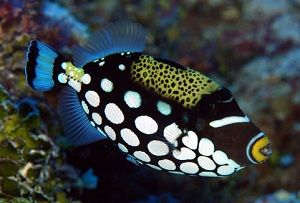Clown triggerfish


- Scientific name: Balistoides conspicillum, Balistes niger, Balistes conspicillum
- Common Name: Clown Triggerfish
- Aquarium size: 1,000 liters
- Temperament: Solitary and aggressive
- Temperature: 24ºC to 26ºC
- pH: 8.2 to 8.4
- Diet: Carnivore
- Length: From 25 cms to 50 cms
Description
The Clown Triggerfish may be one of the most beautiful and original fish in the marine world, which is why it is one of the most sought after by marine photographers.
It belongs to the family of the Ballistids , of the order of the Tetradontiformes, so it is related to the boxfish and the puffer fish . All these families have a very tough skin in common.
Their acclimatization to the aquarium is easy and although in principle they seem to be very resistant fish, it seems that there have been cases of sudden death , so we will be very careful in the first days in the marine aquarium.
Morphology
In the wild they are fish that can reach 50 centimeters long, but in the aquarium they rarely exceed 25 centimeters.
They have an oval and laterally compressed body. Like all triggerfish, they have an erectile spine in the first radius of their dorsal fin, and the second radius of their dorsal fin allows the spine to be unlocked, keeping it in position.
If you look at the photographs, you will see how in some the spine of the dorsal fin is fully unfolded, while in others it is retracted and goes unnoticed.
The most distinctive thing about its anatomy is its coloring. The Clown Triggerfish is black in color, dotted with white spots in its ventral area, which reach up to just over half the fish.
Around the dorsal fin it has a large yellow spot, dotted with black spots.
The fish’s snout is also bright yellow edged with a white stripe. It has other yellow spots near the tail fin, dotted in turn with white spots.
Their eyes are small and set laterally. It has a white stripe under the eyes, which can sometimes be yellow.
The coloration of the youngest specimens is slightly different from the adults. They can also have white spots in the dorsal area, although they fade and the colors of the species appear as they age.
Distribution and habitat
The Clown Triggerfish is widespread in the tropical waters of the Indian and Pacific Oceans.
They habitually live around coral reefs, in shallow waters that can reach 75 meters deep.
It is on the reefs and rocky areas where they find their food: oysters, lobsters, crabs, prawns …
Aquarium conditions
The aquarium must be spacious, at least 1,000 liters, where we will see it swimming at intermediate levels.
It is recommended that the marine aquarium is at least 8 months old. Shelters should be provided
within the aquarium , either with corals or with aquarium rocks that allow it to hide.
The quality of the water must move in the following parameters:
- Temperature: between 24ºC and 26ºC
- Salinity: between 1,023 and 1,025
- pH: between 8.1 and 8.4
- gH: between 8º and 12º
They prefer that there is some movement of the water inside the aquarium.
Diet
Its powerful teeth are ready to eat all kinds of mollusks. In nature they eat oysters, mussels, crabs, prawns, small fish … their appetite is voracious, they eat a lot and fast.
In the aquarium, their diet consists of Nereis, mussels, fresh or freeze-dried prawns and squid.
Behavior and compatibility
Their relationships within the aquarium with other species, varies depending on the size of the aquarium.
They do not have to have any problem, as long as they have their space and that others do not bother them, since they are quite solitary fish.
Ideally you should share space with species of the same size or larger, since with other smaller ones they can end up being part of your food.
Reproduction
The Clown Triggerfish scavenge their nests in the sand , where they create a hole to spawn.
Both the male and the female will protect the nest, until the eggs hatch and the fry begin to swim.
They are quite aggressive protecting the nest, and it is known that they delimit an area around the nest in the form of an inverted cone, so that the surface to be protected is greater at the surface than at the edge of the nest.
It is best to move away from their nest, so as not to be attacked.









